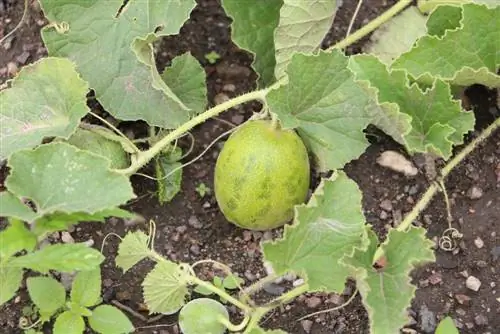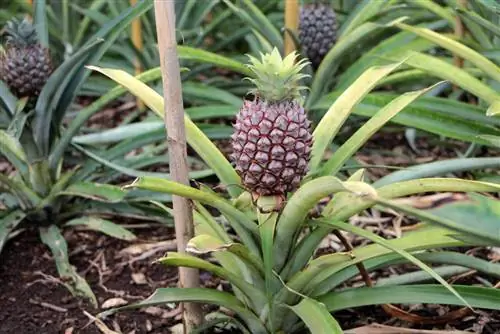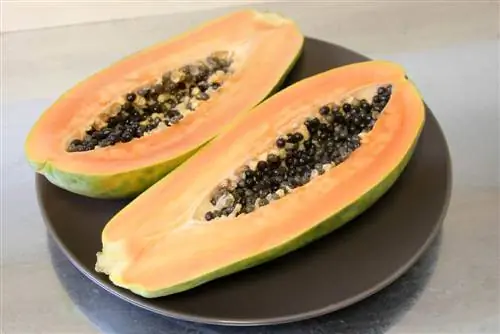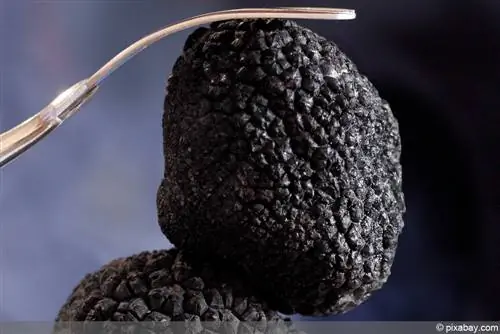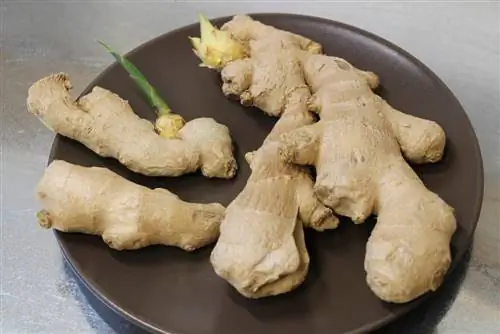- Author admin [email protected].
- Public 2023-12-17 03:39.
- Last modified 2025-01-24 12:45.
The peanut is the seed of the peanut plant. Contrary to its name, it is not a nut, but a legume. The plant grows as an annual and herbaceous and forms taproots up to 50 cm long. Despite the rather cooler climate, peanut cultivation is usually easy, even in our latitudes. This requires the right seeds and favorable environmental conditions.
From seed to nut
As its name suggests, the peanut ripens underground. It is an average of two to six centimeters long and has a relatively woody, net-like shell in which there are two peanut kernels about one centimeter long. The kernels or seeds are also surrounded by a thin red shell. In order for the peanut plant to develop fruit, it uses a very special trick.
Long fruit stalks develop from their yellow butterfly flowers or the lower part of the ovary. They stretch and curve and grow, not towards the light as usual, but rather bore themselves several centimeters deep into the earth. The fruits then form at the tip of these fruit carriers. This property is called 'earth fertility' or 'geocarpy'.
Seed collection
Pre-cultivated peanut plants are rarely available in stores. As a rule, cultivation takes place from seeds or germinable, raw peanuts. You can usually do this easily yourself without any major problems. The seeds you need can be found in online shops, for example. There are now even varieties that thrive even in cooler temperatures. It can be advantageous to pay attention to organic quality. Samples from the supermarket are hardly suitable as they are mostly only offered in roasted form. Once you have purchased the appropriate seeds, the question is whether to sow directly or pre-culture.
Direct sowing or pre-culture?
If you want to grow peanuts yourself, you first have to decide whether you want to grow them in a pot and plant them out later or cultivate them permanently in a pot. Another alternative is direct sowing in the garden, which is also possible in our latitudes, especially in milder locations. In order to develop fruit, these plants need between 130 and 180 frost-free days.
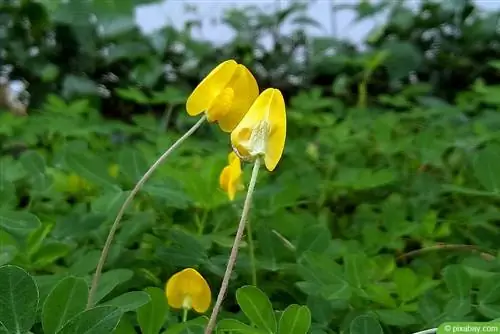
A field culture, for example in the cool north of Germany, would therefore not be very promising. A permanent pot culture makes more sense here. Nevertheless, this fruit can also be grown outdoors in selected regions. Pre-cultivation is usually possible all year round, direct sowing outdoors from around the end of May/beginning of June.
Direct sowing in the bed
Even if sowing seeds in the garden is possible, it is not always successful. In contrast to regions with mild winters, germination would probably not occur in significantly colder locations.
- Soil should have a temperature of at least 18 degrees
- The last frost should have been at least two to three weeks ago
- Soil must be thoroughly loosened beforehand
- This facilitates germination and growth of the shoots
- Choose a sunny and protected place for sowing
- Peanut needs a lot of heat to germinate and grow
- Place the untreated nuts two to three centimeters deep into the soil
- Planting distances of around 20 cm are recommended
- If necessary, place two to three seeds in each hole
- Thin out later and only use the strongest specimens
- Then cover the seeds with soil and moisten them
- Keep the soil evenly moist during the germination process
- Be sure to avoid too much moisture
Tip:
To promote germination, it is advisable to let the seeds soak in a water bath overnight before sowing.
Growing in a pot
To grow peanut plants, you need one or more clean, 10 cm small pots and a nutrient-poor growing substrate. The best time for pre-cultivation is in March/April. As with direct sowing, it is advisable to let the nuts pre-swell.
- Then fill the pots with potting soil
- Place up to five seeds per pot, approximately one centimeter deep into the soil
- Then cover thinly with sand
- From now on, always keep the substrate slightly moist
- Place pots with the seeds in a bright and warm place
- Optimal germination temperatures are between 20 and 25 degrees
- Increase germination by covering with transparent film
- Seeds germinate after about a week
- Repot seedlings from a size of around 10 cm
- Transfer into a lightly fertilized substrate
- Continue cultivation indoors first
- Transplanting when outside temperatures are permanently above 20 degrees
- Depending on the weather, go into the garden from the end of May at the earliest
To grow these fruits permanently in pots, place the young plants individually in 30 cm pots. They should have drainage holes and be equipped with drainage made of pebbles or pottery shards. A suitable substrate is commercially available vegetable soil, which is mixed with sand or perlite to improve permeability. Waterlogging must be avoided at all costs. If it is warm enough outside, the pots can be placed on the balcony, terrace or in front of a warming house wall.
Prepare breeding ground
Ideally, the soil consists of loose, loose earth. If it is rather heavy, you can improve it by mixing in a little sand. You can also add some compost. It should only be added in small quantities because it produces a lot of nitrogen. Since the peanut itself is a nitrogen producer, there would be an oversupply, which in turn affects plant growth. Clayey soils are completely unsuitable for this plant as they are difficult to improve. They should be avoided. If the soil or the pH value is too acidic, adding a little lime can balance it out.
Planting instructions
- First dig appropriately sized planting holes
- Because of the long taproots, at least 15 cm deep
- Now carefully remove the peanut plant from the pot
- Plant as deep as it was in the pot
- Planting distances of approx. 25 cm recommended
- Then pour the whole thing
- Earth must under no circumstances be dripping wet
For young plants without bales, first fill the 15 cm deep holes with about five centimeters of loose soil. Otherwise the young seedlings could sit too deep in the soil, which would be counterproductive to their development. Only the roots should sit in the soil, the stems and leaves should be on the ground. After inserting, the planting holes are filled with loose soil and watered.
Subsequent care
Growing this snack is of course not possible without a certain amount of care. It is usually sufficient to lightly water the peanut plant once a week, preferably with a watering can. It is optimally cared for when the soil is dry on the surface and slightly moist at a depth of approx. 2.5 cm. Fertilizer can usually be dispensed with completely.
If you still want to fertilize, you should fertilize as conservatively as possible and not contain too much nitrogen. A few weeks after planting, when the plant size is about 15 cm, it is advisable to loosen the soil around the plant a little. After flowering, the shoots that gradually form bend downwards and grow into the ground. This is easiest to do when the soil is loose.
What happens next
Once the shoots have finally found their way into the soil and are about 30 cm high, pile up the soil around the plants to form small mounds. This is intended to provide the fruits growing on the underground shoots with more heat and protect them from other external influences. In addition, an approximately 5 cm thick layer of grass clippings or straw that is placed on the piled up hills is recommended. This form of cover provides additional warmth and suppresses the growth of weeds.
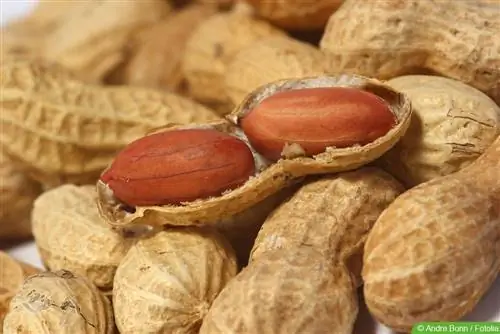
Unfortunately, peanuts can easily fall prey to voles or squirrels, although voles usually don't stop at the roots. You can counteract this with commercially available wire mesh or another close-meshed wire. The wire is inserted into the ground some distance away from the plants, at least 10 cm deep. That's usually enough to keep these rodents away.
Tip:
Conventional mulch made from wood chips is completely unsuitable as a cover. On the one hand, they are too heavy and prevent further shoots from growing into the ground.
The Harvest
The best thing about growing peanuts is of course the harvest. It takes about six months from sowing to harvest. The main harvest time is in September/October. It should definitely be completed before the first frost because the fruits are sensitive to frost.
- A single peanut plant produces between 30 and 50 individual fruits
- Wilting and yellow plants, signs of fruit ripeness
- To be sure, randomly dig up a plant and test it
- To harvest, carefully loosen the soil with the digging fork
- Then pull the entire plant including the fruits out of the ground
- Then carefully shake off the adhering soil
- Peanuts should stick to the plant
- Check the soil again for fallen fruit
- Hang peanut plants in a warm, dry place, out of direct sunlight
- Let dry for three to four weeks
After two weeks, remove the remaining soil and peel off the fruits or pods with your hands. They are then spread out to dry for two weeks. High humidity should be avoided during drying. By the way, peanuts only develop their true aroma after they have been roasted.
Tip:
The harvested plants and their roots are best disposed of in the compost because they are particularly rich in nutrients.


